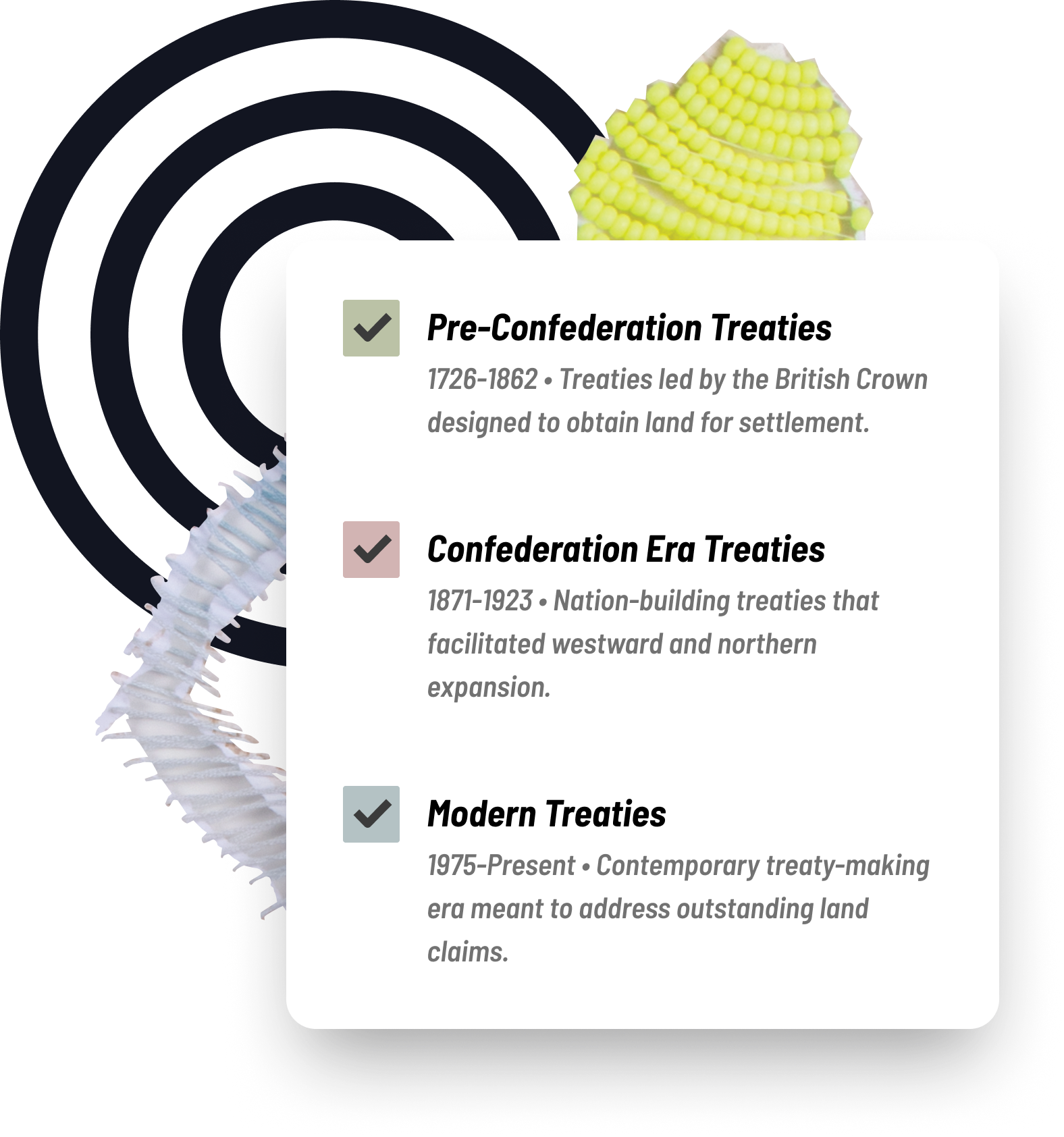Covering every Canadian treaty from 1763 to the present, The Treaty Map aims to challenge the commonly held view of treaties as land surrenders and offers a comprehensive, interactive learning and teaching tool, grounded in Indigenous perspectives of treaties.

Learn more about the Eras of Treaty-Making
Pre-confederation treaties are those negotiated from 1763, the date of King George III’s treaty-making Royal Proclamation to 1862, just before Canadian Confederation. The treaties captured in this era represent early English attempts to establish sovereignty, obtain land for settlement and colonization. They were considered transactions, above all else. From a First Nation perspective, however, these agreements served to solidify a post-war alliance and represented peace, friendship, and sharing agreements. These early colonial treaties, sometimes called the “blank” treaties, often lacked documentation, were negotiated very quickly, and plagued by confusion and obfuscation. It is no surprise, then, that nearly all of the pre-confederation era treaties were — or continue to be — contested in litigation and negotiation. The treaties in this era are a record of Canada’s attempt to dispossess Indigenous people from the land and assert sovereignty via deception and fraud.
The Confederation era treaties – often simply referred to as the “Numbered Treaties” – are those negotiated from 1871 to 1923. After 100 years of pre-confederation era treaty negotiations, First Nations North and West of the Great Lakes began demanding clearer terms in treaties, so Canada applied a strategy of standardization. They sought land surrender and relocation to make way for settlement, paired with modest services, annuities and occasionally support for a transition to European-style agriculture. For their part, First Nations continued to exercise their view of treaties as sharing agreements that reflected shared sovereignty and relationality. In most First Nation accounts of these treaties, settlers were simply obtaining access to land “no deeper than the depth of a plow” with limited impact on their day-to-day lives. But when these competing visions of treaties resulted in conflict, the Indian Act was deployed to coerce First Nations to abide by the Crown’s interpretation of terms. The fight for a just interpretation of the Numbered Treaties endures.
The so-called Modern Treaty era began in 1975 and continues into the present. Following the conclusion of the Numbered treaties in 1923, Canada abandoned treaty-making. But First Nations, Inuit and Métis protested the illegal occupation of their land and exploitation of their resources in Quebec, the West and the North. This unfolded in the courts with the Calder Decision, resistance to the 1969 White Paper, and the MacKenzie Valley Pipeline Inquiry. Paired with Canada and the territories’ rush to develop hydroelectric and oil and gas resources, a new land claim process emerged, resulting in modern treaties. While treaties in this latest era are more comprehensive in scope, access to the land remained the overarching goal for Canada. In exchange for extinguishing, modifying, or not asserting title to the vast majority of their territories, First Nation, Métis and Inuit in the modern treaty era secured financial compensation, consultative rights, and options to negotiate self-government. The challenge, as with previous eras, is their lack of implementation
Indigenous diplomacy and treaty-making pre-dated Canada and has been practiced before and during Pre-Confederation, Confederation and even Modern Treaty eras. This diplomacy draws on Indigenous legal traditions, from each part of the country, and is embedded in creation narratives, social organization, governance protocols and formalized negotiation with other Indigenous people and with settlers. It has sought to enshrine principles of mutual autonomy, shared sovereignty and relationality as well as the agency of the land and reciprocity. As Canadian treaty-making practices came to dominate the relationship, Indigenous diplomacy nonetheless endured, challenging unilateral assertions of sovereignty and the commodification of the land. This resistance has formed the basis of arguments against concepts of land surrender or treaties as transactions and continues to drive contemporary Indigenous interpretations of treaties as well as the creation of new Indigenous-led treaties.
Each Treaty Era is distinct. Pre-confederation, Confederation and “Modern” were negotiated in similar contexts (often aligning with moments in Canadian nation-building) and have similar terms. They can even be thought of as a “type” of treaty, with their nature and scope distinguishing them from treaties in other eras.
There are a few instances where treaties were negotiated under a pre-existing framework agreement (Yukon Umbrella), or, where a group of treaties were later consolidated into a “basket” (Williams Treaties). While difficult to represent on the map, we hope the descriptions make the distinction between the “group” and specific treaty clear. Finally, Canada has always resisted notions of overlapping or shared Indigenous territories – it was far more common than the Map depicts and the lack of overlap is a reflection of a colonial approach to treaty making generally.
The Proclamation – and subsequent 1764 “Twenty-Four Nations-Belt” negotiated at Niagara – marked a turning point, from Indigenous-led treaty making to a new framework established by the English following their defeat of the French in The Seven Years War. The Proclamation empowered England but simultaneously recognized Indigenous land rights, compelling treaties. This complicated transition is captured in Michelle’s Sound’s “Proclamation” artwork, featured on The Treaty Map site. Learn more about this art piece on the About page.
Since 1763, Canada has sought to eliminate Indigenous forms of land tenure; reducing Indigenous title and rights using concepts like surrender, cede and extinguish. These concepts are central to Canadian narratives of treaties. But the Map attempts to offer Indigenous narratives, which challenge the philosophy and practice of “surrender” and re-centre relationality and mutual autonomy.



